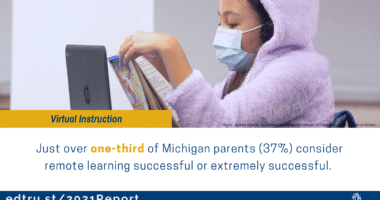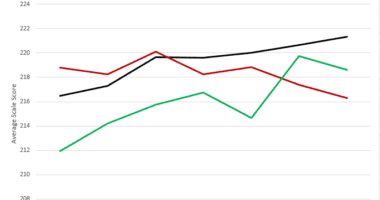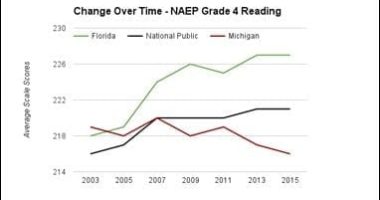Mich. Needs Better Prepared Grads
Too Few Students Prepared for College or Career
New data from the “Nations Report Card” show that high schools have not prepared students – especially low-income students and students of color – to pursue whatever postsecondary path they may choose after high school.
Results from the 2015 12th-grade National Assessment of Educational Progress (NAEP) show that while there are long term gains in reading and math for low-income and Latino students, there is no national long-term improvement for black and Native students.
For most groups of students – including students of color and low-income students – 12th-grade NAEP scores have declined or stagnated in both reading and math since 2013.
“Simply put, high schools are treating graduation as the end goal for too many low-income students and students of color, rather than ensuring that all students have access to learning opportunities that will prepare them for college and the workplace,” said Amber Arellano, executive director of The Education Trust-Midwest. “These results create a real urgency to build strong high schools that meet with students’ and parents’ future goal. Let’s not waste it.”
Talent Forecast Shows Growing Need for a Highly Educated Workforce
A new report, Business Leaders’ Insights: Michigan’s Talent Forecast, shows that the goal of helping Michigan become a “Top Ten” state will be impacted by Michigan’s ability to supply talent with the right education, training and skills to fill high-paying, high-demand jobs.
“High-paying jobs—the ones that require more education and training—are going to continue growing in Michigan in the near term while low-skill, low-wage jobs are expected to contract.” said Doug Rothwell, Business Leaders for Michigan president and CEO. “However, most of the jobs in Michigan are still low-skill and low-wage.”
According to the report, jobs requiring only a high school diploma are expected to drop by more than 19,000, while jobs requiring an associate’s degree or higher are projected to grow by more than 21,000.
“Michigan residents are 10th oldest in the nation,” Rothwell said. “Coupled with a declining population of K–12 students, a low percentage of 25–34 year olds, and continuing low educational attainment, we face a significant talent gap over the long term.”
A full copy of Business Leaders’ Insights: Michigan’s Talent Forecast is available here.
Capitol Update
‘SCHOOL BUS’ PASSES HOUSE. Last week, the Michigan House of Representatives passed the fiscal year 2016-17 school aid omnibus budget, 72-36. The budget, which would take effect on October 1, includes an increase of $150 million for per-pupil spending, increases funding for districts with high proportions of at-risk students and includes a nearly $24 million investment in early literacy improvement initiatives.
Notably, however, this budget also eliminates funding for the M-STEP, ACT WorkKeys and SAT College Entrance assessments. Forcing another change in end-of-year tests would be disruptive to schools and damaging to students. The elimination of the SAT College Entrance exam would be particularly harmful for low-income and first-generation students, who may not otherwise be able to take the college entrance exam.
Michigan has provided a college entrance exam, free to students, since 2007.
Upcoming Meetings:
House Appropriations Committee. Today, May 3 at 10am. Room 352 of the State Capitol Building. Agenda: House Bill 5382 (Pscholka – R), HB 5383 (Price – R), HBs 5384 and 5387 (Garica – R), Senate Bills 711 and 820 (Hansen – R), and SB 822 (Knezek – D), regarding Detroit schools. Click here for a live stream of the meeting.
State Board of Education. Tuesday, May 10 at 9:30 am. Ladislaus B. Dombrowski Board Room, Fourth Floor, Hannah Building. The agenda will be available here.






